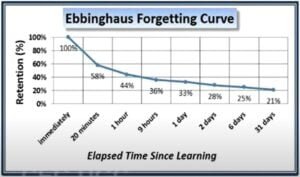There are few Classical studies in memory which will make you amazed. According to Woodworth, ‘Memory involves learning, retention, recall & recognition.’
1. Atkinson and Shiffrin’s Modal Model (1968):
This model describes memory as consisting of three main stages:.
- Sensory Memory- (where information is briefly held from our senses. It store information for 1-4 seconds
- Short-term memory (STM) – where we actively process and manipulate information . It store information for 15- 30 seconds
- Long-term memory (LTM)– where information is stored for longer periods
2. Ebbinghaus’ Forgetting Curve (1885):
This study showed that we forget newly learned information quickly at first, but the rate of forgetting decreases over time. So, if you don’t review what you’ve learned, you’re likely to forget it faster.
Hermann Ebbinghaus (1913), first researchers who study forgetting by using “nonsense syllables (WOL, GEX),” He found that spacing out one’s study sessions (distributed practice) will produce far better retrieval of information studied in this way than does massed practice, or study all at once.

3. Miller’s Magical Number Seven (1956):
Miller suggested that our short-term memory has a limited capacity and can hold about seven items, plus or minus two (7+/-2). So, if you’re trying to remember a list of things, you’re likely to remember around seven items at a time.
4.Tulving’s Encoding Specificity Principle (1972):
Tulving proposed that memory retrieval is most effective when the conditions at encoding (when you first learned something) match the conditions at retrieval (when you try to remember it). For example, if you study for a test in the same room where you’ll take the test, you might remember more because the environment is similar.
5.Baddeley and Hitch’s Working Memory Model (1974):
This model suggests that short-term memory isn’t just one single system but has different components. There’s a “central executive” that controls attention and other systems called the “phonological loop” for verbal information and the “visuospatial sketchpad” for visual information.
6.Craik and Lockhart’s Levels of Processing (1972):
Craik and Lockhart proposed that the way we process information affects how well we remember it. Deep, meaningful processing (like thinking about the meaning of the information) leads to better memory than shallow processing (like just repeating it over and over).
7. Clive Wearing’s Case Study (1985):
Clive Wearing suffered from amnesia, which means he couldn’t form new memories due to damage in his brain. His case showed how crucial memory is for our everyday lives and how different types of memory (like remembering facts versus remembering how to play the piano) can be affected differently.
These theories help us understand how memory works and how we can improve our learning and remembering abilities.
References
1. Ebbinghaus, H. (1885). Über das Gedächtnis: Untersuchungen zur experimentellen Psychologie [Memory: A Contribution to Experimental Psychology]. Duncker & Humblot.
2. Bartlett, F. C. (1932). Remembering: A study in experimental and social psychology. Cambridge University Press.
3. Atkinson, R. C., & Shiffrin, R. M. (1968). Human memory: A proposed system and its control processes. In K. W. Spence & J. T. Spence (Eds.), The psychology of learning and motivation (Vol. 2, pp. 89–195). Academic Press.
4. Miller, G. A. (1956). The magical number seven, plus or minus two: Some limits on our capacity for processing information. Psychological Review, 63(2), 81–97. https://doi.org/10.1037/h0043158
5. Tulving, E. (1972). Episodic and semantic memory. In E. Tulving & W. Donaldson (Eds.), Organization of memory (pp. 381–403). Academic Press.
6. Baddeley, A. D., & Hitch, G. J. (1974). Working memory. In G. H. Bower (Ed.), The psychology of learning and motivation: Advances in research and theory (Vol. 8, pp. 47–89). Academic Press.
7. Craik, F. I., & Lockhart, R. S. (1972). Levels of processing: A framework for memory research. Journal of Verbal Learning and Verbal Behavior, 11(6), 671–684. https://doi.org/10.1016/S0022-5371(72)80001-X
8. Sacks, O. (2007). Musicophilia: Tales of music and the brain. Vintage Books.
